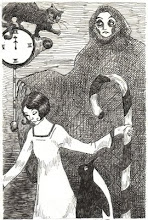 When I really stop to think about it, I may divide all movies and theater into one of two categories: Boring and Not Boring. Sadly, to modern audiences, many silent melodramas fall squarely in the realm of the Boring. Not so with The Man Who Laughs! The whole thing is just a non-stop delight. If you've been looking for a horror-melodrama with a swashbuckling clown: this is pretty much your only option.
When I really stop to think about it, I may divide all movies and theater into one of two categories: Boring and Not Boring. Sadly, to modern audiences, many silent melodramas fall squarely in the realm of the Boring. Not so with The Man Who Laughs! The whole thing is just a non-stop delight. If you've been looking for a horror-melodrama with a swashbuckling clown: this is pretty much your only option.The film is based on the rarely read Victor Hugo novel of the same name. In it, Gwynplaine, a small boy is sold to child mutilating gypsies called The Comprachicos by agents of King James II because of his noble father's disloyalty to the crown. Little Gwynplain's face is carved into a gruesome and permanent smile, while his father is tortured to death in an iron maiden. Gwynplaine is abandoned by the Comprachicos when they are forced to leave England and don't want any mutilated children with them, as the mutilation of children is usually frowned upon. So, the poor child wanders a frozen, barren landscape with a scarf covering his grotesque smile. This scene is completely extraordinary. It's German Expressionism at it's creepy best, wearing it's surrealistic influences on its sleeve. Gwynplaine walks through a field of gibbets hung with half rotted corpses.
He sees a young woman frozen to death on the road, but the baby in her arms is still alive and Gwynplaine saves her life by taking her along with him. He soon comes to the cabin of a hermit/mountebank/philosopher who kindly takes the children into his home, which he shares with his (really, really unfortunately named) wolf, Homo. The part of the wolf is played by an exceptionally sweet faced German Shepard named Zimbo. The baby turns out to be blind.

A couple of decades past and Gwynplaine and his ad hoc family make a living by performing a clown show/freak show in carnivals where he is billed as "The Man Who Laughs". The blind infant has grown up into a beautiful, sweet young woman. The carnival scenes are just the best. They are filled with life and movement, and the kind of hysterical enjoyment achieved only by people whose lives are unremittingly dark, hard working and grim. The extras are just incredible. They are present and lively and it appears they were cast via time machine. Wanted: Hordes of Syphilitic Rabble! There is some fun contrast between the chaotic fun of the fair grounds, and what passes for entertainment in the court of Queen Anne, who sits toad-like and frowning on her throne (the actress looks just like John Tenniel's Queen of Hearts). A decadent duchess becomes entranced with Gwynplaine, and we subsequently find out she is living on his father's estate and if Gwynplaine is reinstated as a peer of the realm she will lose all unless she marries the grotesque carnival player.

Court intrigue proceeds, more roiling crowds of rabble, some swashes are buckled, Homo saves the day and the lovers are eventually reunited. It's exciting and well acted in a hammy way, the girl is pretty, everyone else is a glorious grotesque, so the film has a great deal to offer. But, the design is the thing that is just mind blowing. Every frame is so rich and well thought out and manages to be both slightly off and expressionistic, but still brimming with interest and life. And a clown swashbuckles.
It's kind of amazing to me that a novel by Victor Hugo that essentially nobody's read has wielded so much cultural influence over the past 75 years or so. Of course, lots of this influence is cast by the wonderful film adaptation. A silent from 1928. That few living people have seen, considering the numbers who have seen and enjoyed its progeny.
The clearest and most acknowledged child is of course Batman's arch-enemy, The Joker (I mean, hello. Look at the poster at left). Bob Kane freely admits that he more or less stole the imagery from Conrad Viedt's distorted face. The similarities are emphasized in 2008's Dark Knight where Heath Ledger's joker speaks of his father cutting a permanent smile into his face. The largest difference, of course is that Hugo's hero is an admirable character, someone to be pitied, and The Joker is a psychopath. J.D. Salinger's Laughing Man owes more than a little to The Man Who Laughs, too. But I first came to the story through James Ellroy's novel The Black Dahlia, based on the notorious unsolved murder of b-girl, Elizabeth Short. Imagery from Hugo's novel plays a major part in the operatically over the top ending.
It's just such a strange anomalous work. The story is so strange, yet clearly so resonant, it has turned into fairy tale or myth.

















No comments:
Post a Comment